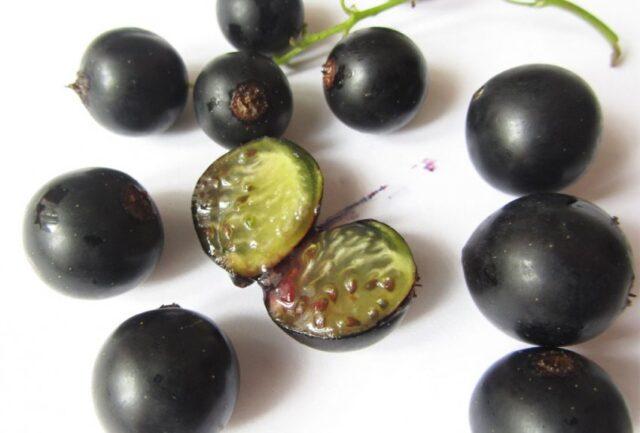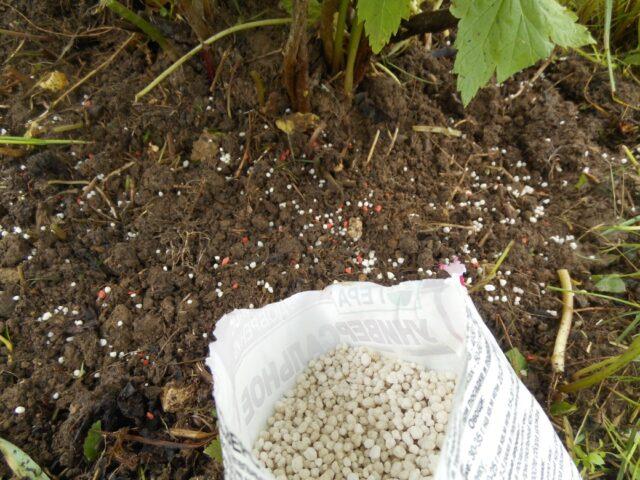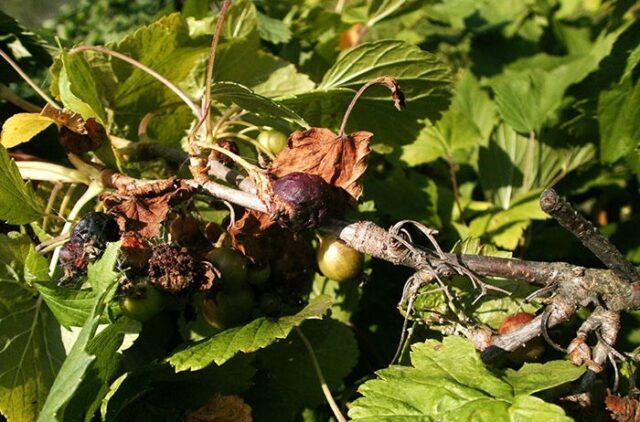Content
Choosing a currant variety for a summer cottage is fraught with difficulties. The plant must be unpretentious, adapt to the climatic conditions of the region, and bear fruit abundantly. Modern breeders believe that Nightingale Nightingale currant meets all these requirements. In addition, the culture has an excellent dessert taste.
History of selection
The blackcurrant variety Nightingale Night was obtained in Russia, in the Bryansk region, at the Lupin Research Institute. The culture was the result of crossing the Selechenskaya 2 and Sokrovische varieties. The authors of the new product are scientists A. I. Astakhov and L. I. Zueva. The crop has been in state variety testing since 2009.

Currant Nightingale Night is famous for its large sweet berries, the weight of which can reach up to 4 g
Description of the blackcurrant variety Nightingale Night
The bush is low, the shoots are erect, smooth, thick. Over time, they become covered with dense gray bark. The buds are oval, pointed at the ends, deflected from the stem, the surface is covered with light fluff.
The characteristic three-lobed leaves of currants are dark green, soft, and wrinkled. The edges are uneven and jagged. The petiole is strong, slightly colored.
Light purple flowers are produced on long, twisting racemes of up to ten flowers each.
The fruit bunch is medium in size, the berries are not densely spaced. Ripened currants have a regular, round shape, black color, the skin is thin but dense, smooth and shiny, not pubescent. The fruits are easily separated from the cluster, the juice does not flow out. The average weight of the berry is approximately 2.7 g, with good and proper care it can reach 4 g. Tasting score - 4.9 points. The taste is sweet, the aroma is pronounced.
Characteristics
Black currant Nightingale Night is distinguished by its early ripening period. In central Russia, the berries turn black in the first half of June.
Drought resistance, winter hardiness
The currant variety Nightingale Night is moderately resistant to prolonged drought. The culture tolerates frosts and snowless winters well.

Snow provides additional cover for shrubs in winter, and in spring it saturates the plant with moisture.
Pollination, flowering period and ripening time
To get a good harvest of Nightingale Night blackcurrant, you need to select pollinating varieties. There may be several of them; the bushes are planted nearby, on one summer cottage. In May, cross-pollination occurs during flowering. The most common variety suitable for these purposes is Golubka. You can also plant Leia, Neapolitan, Exhibition.

Even self-fertile blackcurrant varieties need pollinators, this will significantly increase their yield
Early black currant Nightingale Night blooms with the arrival of May. Fruit ripening begins after 40-45 days (mid-June).
Productivity and fruiting
From one adult Nightingale Night currant bush you can collect up to 1.5 kg of berries. Under favorable climatic conditions, this figure can increase to 2 kg.

The yield indicators of the Nightingale Night currant are quite modest, but this disadvantage is compensated by the mass and sweet taste of the berries
After planting, the young plant begins to bear fruit in the next season. With proper autumn pruning, the yield increases every year, its peak occurs in 6-8 years. On average, the crop retains its productive qualities for up to 12 years.
The berries ripen quickly and they begin to be picked in the first half of June. The process is simple, since the currants are easily separated from the brush.

Dry separation of fruits guarantees their integrity during storage and transportation
Resistance to diseases and pests
The blackcurrant variety Nightingale Night is resistant to fungal diseases, in particular powdery mildew. The culture is not afraid of bud mites and other major pests of fruit and berry bushes.

The bud mite destroys currant buds, leaf growth stops
Advantages and disadvantages
The variety has virtually no disadvantages. These include early ripening with a high probability of return frosts in regions with a difficult climate.
Advantages of the variety:
- high taste qualities;
- resistance to pests and diseases;
- unpretentiousness;
- versatility in the use of fruits.
The berries of the variety are distinguished by a pronounced currant aroma and a high content of ascorbic acid.
Features of planting and care
It is better to root nightingale night blackcurrant seedlings in September. They will take root before winter and begin to grow in the spring.Planting can be done at the end of March; it is important to do this before the sap flows and the buds begin to swell.
Currant bushes are rooted on fertile loams, in the southern side of the site. It should be well lit and protected from the wind. The close occurrence of groundwater is unacceptable.
At the end of summer, 2-3 weeks before the expected planting date of Nightingale Night currants, dig holes measuring 0.5 x 0.5 x 0.5 m. Maintain a distance between them of 1.3 m. In the row spacing, the intervals are 1.5 m.
The top layer of earth is mixed with 50 g of superphosphate, a handful of ash and humus. Fill the holes more than half with the mixture. Before planting, the nutrient soil will compact and settle.
Immediately before rooting, pour half a bucket of water into the hole. The seedling is lowered into a hole 5 cm deeper than it grew in the mother liquor and placed at an angle of 45ᵒ to the ground level.

To avoid infection, the young bush is not planted in areas previously occupied by raspberries or gooseberries.
The root shoots are straightened, covered with a layer of light, ground earth, and compacted. The seedling is watered abundantly, and after the water is absorbed, the soil is mulched. To stimulate rhizome growth, ground shoots are pruned, leaving short shoots with three buds.

After pruning in the spring, the young plant will grow rapidly and new shoots will appear.
In the spring, before the buds swell, dry shoots and broken branches are cut off from the nightingale night blackcurrant. The soil around the bush is dug up, weeds are removed, watering is carried out, and the mulch is renewed.
In spring, black currants are fertilized and fertilizing containing nitrogen is applied.

The first fertilizers in the new season stimulate the awakening of the plant, the formation of buds, leaves, and ovaries
The soil is loosened twice a week, the bushes can be watered once every seven days, more often if spring and summer are dry.
In June, the bushes are fed with organic fertilizers. Black currant also responds well to foliar feeding.
At this time, the fire butterfly or sawfly may become active in the garden. At the first signs of damage (curled dry leaves, deformation of berries), spray with appropriate preparations.

Modern insecticides successfully fight pests that can destroy most of the crop
After harvesting, the bushes are watered abundantly, and the soil is loosened weekly.
At the end of September, Nightingale Night currants are fertilized with organic matter and the area is dug up. It is important not to skip pruning during this period; it is necessary to remove excess branches and damaged shoots.
Conclusion
Currant Nightingale Night is a fairly young, early variety of Russian selection. The crop is distinguished by abundant fruiting and good taste of berries. The variety is unpretentious, tolerates short periods of drought at high temperatures, and is not afraid of frost. Thanks to this, Nightingale Night currants can be grown in the northern and southern regions of the country without losing the taste of the berries and reducing yields.
Reviews of currant Nightingale Night
The soil on the site is dense, loamy, dry, the garden is blown by the winds. At the same time, I am a lazy summer resident, I don’t water or feed the bushes, in the summer I just mulch generously with hay. Not all fruit and berry crops respond well to such “care”. The Nightingale Night currant bears fruit well, I consistently get my kilogram of berries every year at the beginning of summer. I think if the care is good, the yields will increase significantly.








